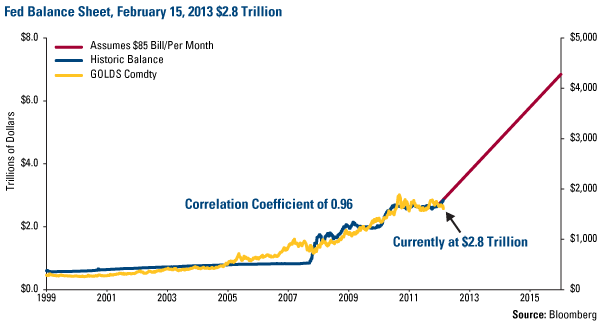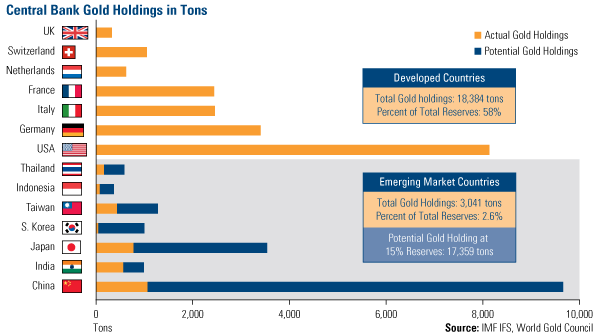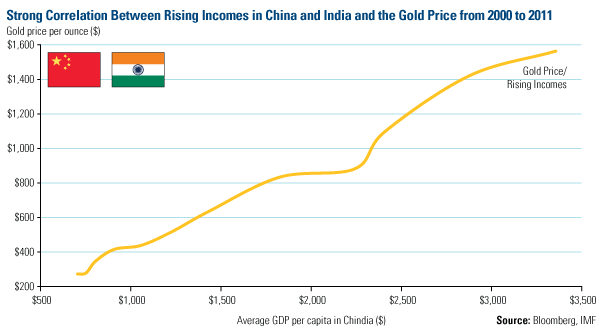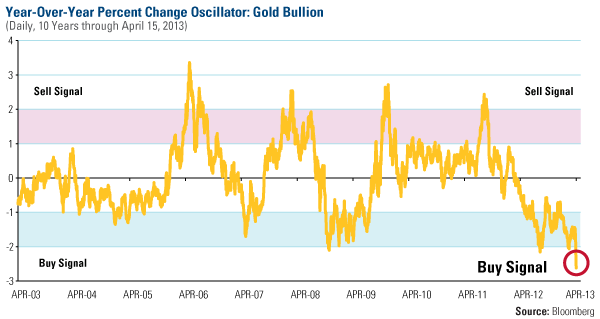Volatility in the gold market often results in extremely bullish and bearish views. Below are 4 facts to remember about gold that should help neutralize such views and allow you to take a more balanced and thoughtful approach to the yellow metal.
So says Frank Holmes (www.usfunds.com) in edited excerpts from his original article* entitled Four Important Facts to Remember About Gold.
This post is presented compliments of Lorimer Wilson, editor of www.munKNEE.com (Your Key to Making Money!) and the free Intelligence Report newsletter (see sample here). The post may have been edited ([ ]), abridged (…) and/or reformatted (some sub-titles and bold/italics emphases) for the sake of clarity and brevity to ensure a fast and easy read. You can also “Follow the munKNEE” daily posts via Twitter or Facebook. Please note that this paragraph must be included in any article re-posting to avoid copyright infringement.
Holmes goes on to say in further edited excerpts:
1. You can’t print more gold
The Federal Reserve continues to print…$85 billion every month…and research has found that the correlation between the rise in gold and the U.S. balance sheet is 0.96…
2. Gold is viewed as a currency by central bankers
…I feel investors should look at how central banks around the world are viewing their own reserves….The World Gold Council reported that in 2012 central banks purchased 535 tons when only a few years ago central banks were net sellers of gold…While the tonnage is only a fraction of the overall gold market, it is widely acknowledged that central banks are building their supplies of gold as a means to diversify their holdings away from the U.S. dollar and the euro.
3. A lack of love from the Love Trade is affecting fundamentals
…The two emerging countries that make up almost half of gold demand—China and India—have had a long relationship with the precious metal that is intertwined with their culture, religion and economy. With half of the world’s population buying gold for their friends and family, it’s important to put into context what is happening in their countries.
It was announced this week that China’s income growth is at its slowest pace since 2001…This is very important to gold, as China’s income growth has been shown to be highly correlated to the price of the precious metal over the past decade.
…In India, gold consumption has been hurt by both a weak rupee and government taxes on imports. In the first quarter of 2013 alone, gold imports declined 24 percent, according to Mineweb.
4. Corrections happen, but have historically offered buying opportunities
As of the end of April 15, the gold price on a year-over-year percentage change basis registered a -2.6 standard deviation. While minor corrections in the gold price happen frequently, a move this severe has never occurred before over the previous 2,610 trading days.
With gold’s standard deviation drastically below the “buy signal” blue band, we consider the yellow metal to be in an extremely oversold position on a 12-month basis.
The probability that gold will move higher over the next several months is high.
* http://www.usfunds.com/investor-resources/frank-talk/four-important-facts-to-remember-about-gold/
Related Articles:
1. These 5 Events Will Lead to Higher Gold & Silver Prices
It is my contention that the move in precious metals…[from] late 2008 through 2011 was largely a result of the expansion in central bank balance sheets and the perceived threat of runaway inflation. Since 2011, [however,] we’ve seen economic growth improve and inflation rates across the globe subside. As a result, investment banks and market strategists are arguing against owning gold, and making the case that, with a lack of inflation and an improved economy, the need for owning gold as an insurance hedge against inflation and currency debasement is no longer present. I strongly disagree.
2. Central Bank Gold Purchases up 17% – Here’s Why You Should Jump in or Top Up Too
If central banks are preparing for a major change in the value of the dollar, shouldn’t we? The US dollar cannot and will not survive the ongoing abuse heaped upon it by government planners and federal officials. That not only means the gold price will rise, but that many, if not most currencies, will lose a significant amount of purchasing power. This has direct implications for all of us.
3. What Does the Future Hold for Gold? 3 Determinants
The best way to think of gold is as a non-yielding currency with a special trait: The only way to “print” it is to pull it out of the earth at great cost. As a currency with no yield and limited practical use…gold’s investment case largely rests on its ability to insure against currency depreciation. Few people expect to make money by taking out insurance policies. I don’t recommend allocating any more than 10% of a portfolio to gold. Words: 610
4. Startling Relationship Between Gold Price & U.S. Gov’t Debt Suggests What Price for Gold in 2017?
The price of gold, on a quarterly basis, is 86% correlated – yes, 86%! – to total government debt going back to 1975… and a shocking 98% over the past 15 years! [As such,] it would seem like a no-brainer investment thesis to buy gold… as a proxy for the not-otherwise-investable thesis that US total government debt will increase in the future. [But there is more – and it is disappointment for gold bugs – read on!]
5. The Future Price of Gold and the 2% Factor
< p>< p>< p>< p>< noscript>
< p>< p>< p>< p>< noscript>
< p>< p>< p>< p>< noscript>
< p>< p>< p>< p>< noscript>
< p>< p>< p>< p>< noscript> It is my contention that the price of gold rallies whenever the U.S. dollar’s real short-term interest rate is below 2%, falls whenever the real short rate is above 2%, and holds steady at the equilibrium rate of 2%. Furthermore, for every one percentage point real rates differ from 2%, gold moves by eight times that amount per year. So if the real rates are at 1%, gold will move up at an 8% annualized rate. If real rates are at 0%, then gold will move up at a 16% rate (that’s been about the story for the past decade). Conversely, if the real rate jumps to 3%, then gold will drop at an 8% rate. [Let me explain.] Words: 982
It is my contention that the price of gold rallies whenever the U.S. dollar’s real short-term interest rate is below 2%, falls whenever the real short rate is above 2%, and holds steady at the equilibrium rate of 2%. Furthermore, for every one percentage point real rates differ from 2%, gold moves by eight times that amount per year. So if the real rates are at 1%, gold will move up at an 8% annualized rate. If real rates are at 0%, then gold will move up at a 16% rate (that’s been about the story for the past decade). Conversely, if the real rate jumps to 3%, then gold will drop at an 8% rate. [Let me explain.] Words: 982
6. What We Like & Don’t Like About Gold
Whenever a sharp and unexpected correction occurs after many years of gains, one is forced to take a step back and consider whether the bull market has breathed its last. Frankly, we don’t think it has, but the best way to go about this exercise is to consider legitimate bearish arguments. Words: 1853
7. The Gold & Silver Meltdown: 9 Points of View As to What Caused It to Happen
Much has been written about the collapse in the prices of precious metals over the past week. Below are introductions to 9 articles that present different points of view as to what has happened, probably is still continuing and may continue to unfold in the weeks to come.
8. These 40+ Analysts See Gold Going to $5-6,000 (on average) By Late 2014/Early 2015
Analyst after analyst (in excess of 170 at last count) has been forecasting what the parabolic peak price for gold will eventually be. That being said, however, only 43 have been bold enough to include the year in which they think their peak price estimate will occur and they are listed below. Take a look at who is projecting what, by when and why. Words: 400
9. Fed’s Actions Should Cause Gold to Glitter In 2013 – Here’s Why
Gold investors often fail to watch the Federal Reserve with enough attention to detail and can miss buying opportunities like the present one, as a result. The case for gold is as strong as ever and I outline in this article why with details you’re unlikely to see anywhere else. Words: 775; Charts: 6
 munKNEE.com Your Key to Making Money
munKNEE.com Your Key to Making Money
 click to enlarge
click to enlarge click to enlarge
click to enlarge click to enlarge
click to enlarge click to enlarge
click to enlarge





Nice article and I really enjoyed the formatting of the charts along with the text.
I was surprised to see Russia not listed on the Central Bank Chart, as I’m sure they hold Gold.
+
I’d like to repost the comment I made earlier about Gold:
Another interesting thing about Gold is that there is a massive amount of Gold that is contained in seawater! These trace amount of microscopic Gold can be filtered out, something the Koch’s have already looked into, since they also own filtering media manufacturing companies!
If filtering “out” Gold From Seawater (GFS) ever becomes economically feasible then the value of Gold might actually go down since any Company with enough resources (pun intended) could begin to mine the Ocean for Gold, and hopefully they would help clean up the seawater while they are doing it!
This is just one of the reasons that I think that Silver will outperform Gold as a long term investment, especially for those with small amounts of money to invest.